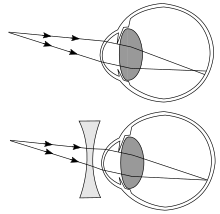

Near-sightedness, also known as short-sightedness and myopia, is an eye disorder where light focuses in front of, instead of on, the retina. This causes distant objects to be blurry while close objects appear normal. Other symptoms may include headaches and eye strain. Severe near-sightedness is associated with an increased risk of retinal detachment, cataracts, and glaucoma.The underlying cause is believed to be a combination of genetic and environmental factors. Risk factors include doing work that involves focusing on close objects, greater time spent indoors, and a family history of the condition. It is also associated with a high socioeconomic class.The underlying mechanism involves the length of the eyeball growing too long or less commonly the lens being too strong It is a type of refractive error. Diagnosis is by eye examination]Tentative evidence indicates that the risk of near-sightedness can be decreased by having young children spend more time outside. This may be related to natural light exposure. Near-sightedness can be corrected with eyeglasses, contact lenses, or surgery. Eyeglasses are the easiest and safest method of correction. Contact lenses can provide a wider field of vision, but are associated with a risk of infection Refractive surgery permanently changes the shape of the cornea[
Near-sightedness is the most common eye problem and is estimated to affect 1.5 billion people (22% of the population). Rates vary significantly in different areas of the world. Rates among adults are between 15 and 49%.Rates are similar in females and males.Among children, it affects 1% of rural Nepalese, 4% of South Africans, 12% of Americans, and 37% in some large Chinese cities. Rates have increased since the 1950s. Uncorrected near-sightedness is one of the most common causes of vision impairment globally along with cataracts, macular degeneration, and vitamin A deficiency.
Signs and symptoms


Near-sighted vision (top/left), normal vision (bottom/right)
A myopic individual can see clearly out to a certain distance, but everything further becomes blurry. If the extent of the myopia is great enough, even standard reading distances can be affected. Upon routine examination of the eyes, the vast majority of myopic eyes appear structurally identical to nonmyopic eyes. In cases of high myopia, a staphyloma can sometimes be seen on fundoscopic examination. Because the most significant cause of myopia is the increase in axial length of the eye, the retina must stretch out to cover the increased surface area. As a result, the retina in myopic patients can become thin and might develop retinal holes and lattice degeneration in the periphery. High myopia increases the risk of retinal tears and detachment. https://en.wikipedia.org/wiki/Near-sightedness
Mit Kurzsichtigkeit oder Myopie bezeichnet man eine bestimmte Form von optischer Fehlsichtigkeit (Ametropie) des Auges. Sie ist zumeist Folge entweder eines zu langen Augapfels oder einer für seine Länge zu starken Brechkraft der optisch wirksamen Bestandteile. Das Ergebnis ist ein Abbildungsfehler, der weit entfernte Objekte unschärfer erscheinen lässt als nahe gelegene – der Betroffene sieht also in der Nähe (daher die Bezeichnung „kurz-sichtig“) besser als in der Ferne. Das Ausmaß einer Kurzsichtigkeit wird durch eine Refraktionsbestimmung ermittelt und in Dioptrien angegeben. Nach Ursache und Zeitpunkt ihres Auftretens lassen sich verschiedene Formen unterscheiden, für die es in den meisten Fällen keine ursächliche Behandlungsmöglichkeit gibt. Durch das Tragen von Hilfsmitteln wie Brillen oder Kontaktlinsen kann jedoch der Brechungsfehler korrigiert werden. Eine operative Korrektur, die heutzutage meist mit Hilfe eines Lasers durchgeführt wird, ist in vielen Fällen ebenfalls möglich.

Strahlengang am kurzsichtigen Auge (jeweils beim Blick in die Ferne; die ankommenden Strahlen sind – entgegen der Darstellung in der Zeichnung – fast parallel zueinander). Beim unkorrigierten myopen Auge (oben) ist die Bildlage vor der Netzhaut und der Seheindruck unscharf. Durch eine Zerstreuungslinse kann die Bildlage nach hinten und bis auf die Netzhautebene verschoben werden, um einen scharfen Seheindruck zu erreichen (unten).
Une myopie (mot d’origine grecque : μυωπία, muôpia, qui signifie « à courte vue ») est un trouble de la vision dont le symptôme principal pour le sujet est de voir flou au loin. L’image d’un point n’est plus un point mais une tache sur la rétine, la perception d’un objet éloigné devient brouillée telle une silhouette et des couleurs dont les contours ne sont pas nets. Plus l’objet est éloigné, plus le flou (pondéré par la valeur de la myopie) est important. En somme, le myope voit moins bien de loin que de près. Ceci peut être corrigé par des lunettes, des lentilles de contact ou par chirurgie réfractive. https://de.wikipedia.org/wiki/Kurzsichtigkeit
On distingue notamment deux principaux types de myopie :
Myopies d’indice (de puissance). Celles-ci sont liées à une augmentation de l’indice de réfraction du cristallin à cause d’une cataracte. Les rayons se focalisent avant la rétine.
Myopies axiales. En ce cas, l’œil est trop long, la focalisation de rayons provenant de l’infini se fait avant la rétine. https://fr.wikipedia.org/wiki/Myopie
Far-sightedness, also known as hyperopia, is a condition of the eye in which light is focused behind, instead of on, the retina. This results in close objects appearing blurry, while far objects may appear normal. As the condition worsens, objects at all distances may be blurry.[2] Other symptoms may include headaches and eye strain. People may also experience accommodative dysfunction, binocular dysfunction, amblyopia, and strabismus.
The cause is an imperfection of the eyes. Often it occurs when the eyeball is too short, or the lens or cornea is misshapen.Risk factors include a family history of the condition, diabetes, certain medications, and tumors around the eye.It is a type of refractive error. Diagnosis is based on an eye exam. Management can occur with eyeglasses, contact lenses, or surgery. Glasses are easiest while contact lenses can provide a wider field of vision. Surgery works by changing the shape of the cornea Far-sightedness primarily affects young children, with rates of 8% at 6 years and 1% at 15 years. It then becomes more common again after the age of 40, affecting about half of people.
Signs and symptoms

Far-sighted vision on left, normal vision on right
The signs and symptoms of far-sightedness are blurry vision, headaches, and eye strain.The common symptom is eye strain. Difficulty seeing with both eyes (binocular vision) may occur, as well as difficulty with depth perception.
Complications
Far-sightedness can have rare complications such as strabismus and amblyopia. At a young age, severe far-sightedness can cause the child to have double vision as a result of “over-focusing”. https://en.wikipedia.org/wiki/Far-sightedness
Bei der allgemeinsprachlich Weitsichtigkeit genannten Übersichtigkeit (Synonym: Hyperopie oder Hypermetropie) handelt es sich um einen sogenannten axialen Brechungsfehler des Auges (Ametropie), bei dem der Augapfel im Verhältnis zur Brechkraft seiner optischen Einrichtung zu kurz beziehungsweise die Brechkraft zu gering ist. Dies führt dazu, dass sich die Bildlage für optisch unendlich weit entfernte Objekte bei entspanntem (nicht akkommodiertem) Auge nicht in der Netzhautebene befindet, und damit eine wesentliche Voraussetzung für einen scharfen Seheindruck nicht erfüllt ist. Stattdessen liegt der (virtuelle) Bildpunkt beim weitsichtigen Auge hinter der Netzhaut, sodass ein unscharfer Seheindruck entsteht. Je näher ein Objekt an das Auge herangeführt wird, desto weiter verlagert sich der Bildpunkt nach hinten. Das Ergebnis ist ein Abbildungsfehler, der nahe Objekte unschärfer erscheinen lässt als weit entfernte – der Betroffene sieht also in der Ferne (daher die Bezeichnung „weit-sichtig“) besser als in der Nähe. Das Ausmaß einer Weitsichtigkeit wird durch eine Refraktionsbestimmung ermittelt und in Dioptrien angegeben.
Die Hyperopie ist vor allem genetisch bedingt. Während zahlreiche Formen von angeborenen Missbildungen des Augapfels mit Hyperopie einhergehen, stellt die Hyperopie allein keine Erkrankung, sondern eine Variante der normalen Augenentwicklung dar.

Strahlengang am weitsichtigen Auge (jeweils beim Blick in die Ferne und ohne Akkommodation). Beim unkorrigierten Auge (oben) würde der Bildpunkt hinter der Netzhaut liegen. Ein unscharfer Seheindruck ist die Folge. Durch eine Sammellinse kann der Bildpunkt nach vorne auf die Netzhautebene verschoben werden (unten) und einen scharfen Seheindruck ermöglichen. https://de.wikipedia.org/wiki/%C3%9Cbersichtigkeit
L’hypermétropie est un trouble de la vision. D’un point de vue optique pur, l’hypermétropie est le contraire de la myopie : quand l’œil est au repos, il donne d’un objet distant une image qui serait focalisée en arrière de la rétine. L’œil hypermétrope est donc un œil dont le système optique n’est pas assez puissant. L’hypermétropie peut être corrigée grâce à des lentilles convergentes prescrites par l’ophtalmologue.
- « Serait », car les rayons lumineux ne peuvent évidemment pas traverser la paroi oculaire : ce n’est que théoriquement que l’image est focalisée en arrière de la rétine.
- « Au repos », c’est-à-dire sans intervention de l’accommodation. L’accommodation qui permet, dans la mesure du possible (voir presbytie), d’augmenter la puissance du système optique de l’œil, l’hypermétropie (l’accommodation « ramène » l’image formée en arrière de la rétine sur cette dernière).
Dans l’absolu, l’œil, toujours au repos (sans accommodation), verrait les objets d’autant plus flous qu’ils se rapprochent. https://fr.wikipedia.org/wiki/Hyperm%C3%A9tropie
